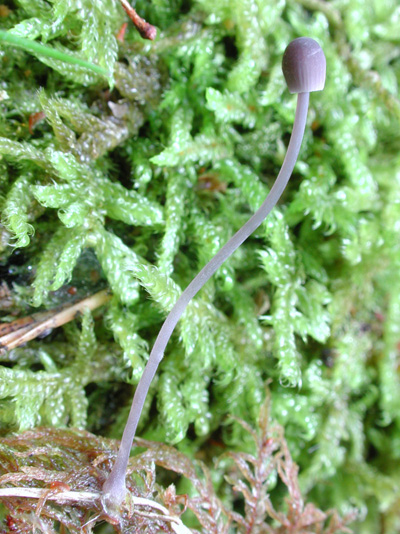Among mosses or on vegetable debris under
conifers, among ericaceous plants, in mountain Betula forests and in arctic/alpine habitats. Summer to autumn. Rarely recorded and probably rare or absent in most of the area covered. Known at least from the Czech Republic, Finland, Germany, Norway, Poland, Slovakia, Sweden, Switzerland and the UK (Scotland). Widespread, but not very common, in Norway.
Pileus 5-16 mm across, conical to convex, sulcate, translucent-striate,
pruinose, glabrescent, at first blackish violet, then bluish grey or greyish with or without
a faint violet hue, dark grey at the centre, finally turning grey to grey-brown. Lamellae
17 - 20 reaching the stipe, ascending, narrowly adnate to somewhat broader adnate, not decurrent with a tooth,
in young specimens sometimes violet-blue, then white to grey, occasionally with a brownish flush, the edge concolorous to white. Stipe
20-65 x 0.5-1 mm, hollow, straight to somewhat flexuous, terete,
equal, pruinose, glabrescent except for the pruinose apex,
lilaceous grey to slate grey, darker towards the base, the
base covered with white fibrils. Odour
and taste indistinctive.
Basidia 23-25 x 7-8 μm, clavate, 4-spored, rarely 2-spored. Spores
(from 4-spored basidia) 7-10.2 x 3.5-5 μm, Q 1.6-2.5, Qav ≈ 1.9, pip-shaped, smooth, amyloid. Cheilocystidia
19-50 x 8.5-25 μm, forming a sterile band,
clavate or obpyriform, mostly long-stalked, apically covered
with few to numerous warts or straight to curved excrescences
1.5-10 x 1-1.5 μm. Pleurocystidia
similar. Lamellar trama dextrinoid. Hyphae of
the pileipellis 2-8 μm wide, densely
covered with warts or short cylindrical, simple to branched excrescences 2-5 x 0.5-1 μm. Hyphae of the cortical layer of the stipe 2-3.5 μm wide, covered with cylindrical excrescences 0.5-2 x 0.5 μm, terminal cells up to 8 μm wide, clavate, densely diverticulate. Clamp connections present at all tissues in 4-spored specimens.
Mycena urania belongs to sect.
Filipedes, where it can be identified on account
of the bluish grey colours in both the pileus and the stipe
(and even sometimes in the lamellae). It shares micro-characters with M. metata and M. filopes, which can be found in the same habitats. Those species smell of iodoform when drying out and are devoid of any blue or violet colours.
Microphotos of cheilocystidia
Microphoto of spores
Microphotos of pileipellis
Microphoto of teminal cells
Go
to sect. Filipedes.

© Michael Krikorev |